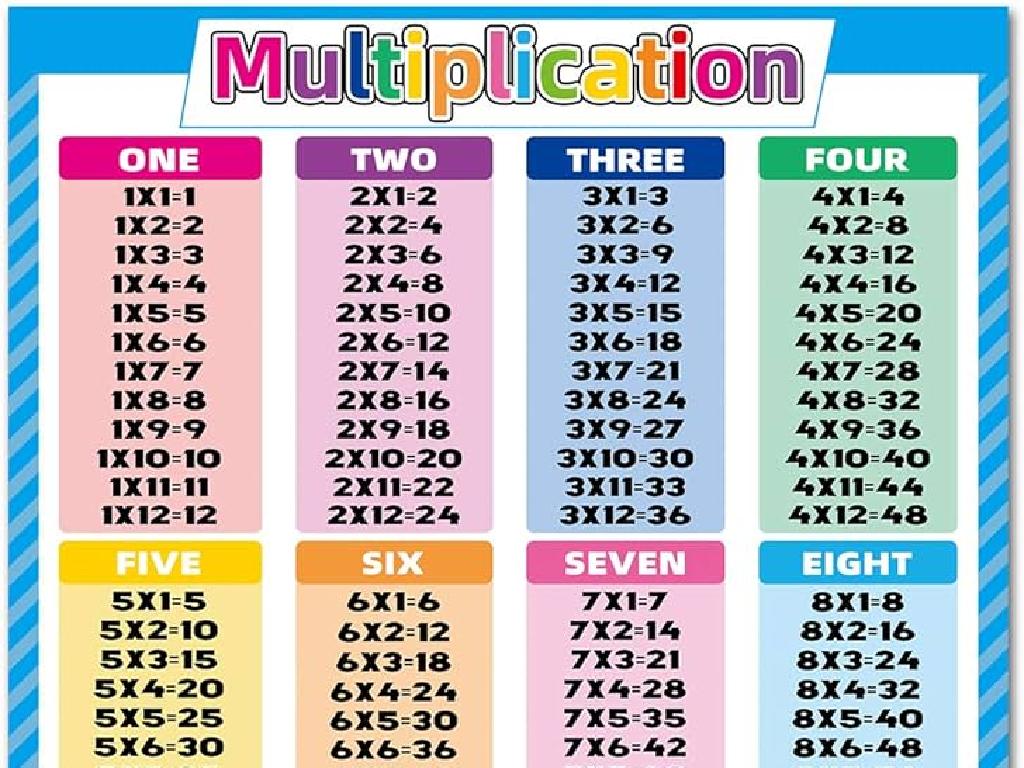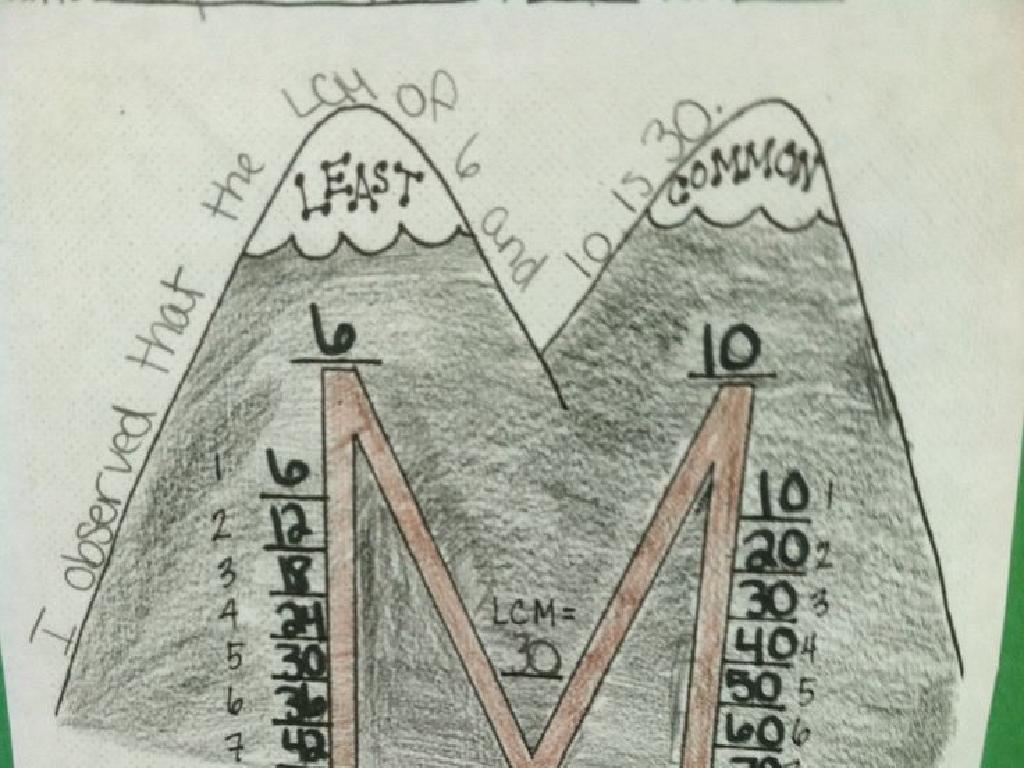Counting On The Hundred Chart
Subject: Math
Grade: Kindergarten
Topic: Numbers And Counting To 100
Please LOG IN to download the presentation. Access is available to registered users only.
View More Content
Welcome to Numbers: Counting on the Hundred Chart
– Today’s focus: Learning to count!
– Introducing the ‘Hundred Chart’
– A grid with numbers 1-100 to help us count
– Counting shows quantity
– Like counting apples in a basket
– Practice makes perfect
|
This slide introduces the concept of counting to Kindergarten students using a Hundred Chart. The Hundred Chart is a visual tool that displays numbers from 1 to 100 in a grid format, making it easier for young learners to understand the sequence of numbers and the concept of counting. Emphasize that counting is a way to determine the total number of items in a group, such as counting apples in a basket. Encourage students to practice counting with the chart to improve their number recognition and counting skills. Activities can include pointing to numbers as the class counts together, finding and coloring specific numbers, or counting by 2s, 5s, and 10s to introduce early skip counting.
Exploring the Hundred Chart
– What is a Hundred Chart?
– A grid with numbers 1 to 100
– Helps with counting and math
– Use it to count, add, and subtract
– Each row has 10 numbers
– Count across rows to practice
– Practice counting to 100
|
Introduce the Hundred Chart as a valuable tool for understanding numbers and their patterns. Explain that it’s a grid filled with numbers from 1 to 100, which helps us visualize and learn counting, addition, and subtraction. Highlight that each row contains 10 numbers, making it easier to count by tens. Encourage the students to practice counting from 1 to 100 using the chart, and to notice patterns, such as how the numbers change from one row to the next. This will help them become more comfortable with number sequences and basic arithmetic operations.
Let’s Count Together!
– Counting from 1 to 10
– Start at 1, end at 10
– Point to each number
– Use your finger to follow along
– Join in counting aloud
– Say the numbers with me
– Practice makes perfect
|
This slide is designed to engage Kindergarten students in a counting activity using a hundred chart. Begin by demonstrating how to count from 1 to 10, ensuring that each child is focused and able to see the chart. Encourage the children to point to each number on the chart as the class counts together. This will help them associate the numerical symbol with its name. Ask the students to join in and count out loud with you, which will help with their number pronunciation and memory. Repeat the activity several times to reinforce their counting skills. The goal is to make them comfortable with the sequence of numbers and to recognize them visually on the chart.
Counting by Tens on the Hundred Chart
– Skip counting by tens
– Counting in groups of ten like 10, 20, 30…
– Jump on tens places
– Imagine hopping from one group of ten to the next on the chart
– Practice: 10, 20, 30… to 100
– Let’s count together: start at 10 and add 10 each time
– Understand tens in numbers
|
This slide introduces the concept of skip counting by tens, which is a foundational skill in understanding place value and number patterns. Start by explaining that skip counting by tens is like hopping from one tens place to another on the hundred chart. Demonstrate this visually if possible. Practice counting aloud from 10 to 100 by tens to help students hear and see the pattern. Emphasize the concept of ‘tens’ and how each jump increases the number by ten. Activities can include using a hundred chart to visually skip count, singing a counting by tens song, or having students physically jump in place as they count to embody the concept of ‘skipping’.
Finding Numbers on the Hundred Chart
– Listen for a number I say
– Who can point to number 15?
– Find 15 on your chart and show us
– Let’s find numbers as a team
– We’ll find numbers together on the chart
– Practice makes perfect
– The more we practice, the faster we get!
|
This slide is designed to engage Kindergarten students in a fun and interactive activity to help them become familiar with the hundred chart. Start by calling out a number and having the students find and point to it on their charts. Highlight the number 15 and encourage a student to show it to the class. Then, as a group activity, find several numbers together, guiding them through the chart. Reinforce the concept that regular practice with the chart will help them recognize numbers more quickly. This activity not only helps with number recognition but also with understanding the sequence of numbers and their positions relative to each other.
Counting Past 10 on the Hundred Chart
– What comes after number 10?
– Counting from 11 to 20
– After 10, we have 11, 12, 13, up to 20
– Numbers repeat with a ‘1’ in front
– 11 is like a ‘1’ then another ‘1’, 12 is a ‘1’ then a ‘2’, and so on
– Practice counting 11-20
– Let’s count together on the chart
|
This slide introduces the concept of counting past 10, which is a foundational skill in understanding the base-10 number system. Start by asking the students what number comes after 10 to engage them. Then, guide them to count from 11 to 20, emphasizing the pattern that emerges as each of these numbers begins with the digit ‘1’. Use a hundred chart to visually demonstrate this pattern and help them recognize the sequence. Encourage the students to practice counting from 11 to 20 out loud and with the chart. This will help solidify their understanding of the number sequence and prepare them for counting to higher numbers.
Practice Time: Counting 1 to 20
– Point and count with me
– Start at number 1
– Place your finger on the number 1
– Count aloud to 20
– Say each number as you move your finger
– Practice makes perfect!
– The more we count, the better we get!
|
This slide is an interactive activity designed to help Kindergarten students practice counting on the hundred chart. Encourage the students to use their fingers to physically point to each number on the chart as they count aloud from 1 to 20. This tactile and auditory exercise helps reinforce number recognition and the sequence of numbers. As the teacher, lead the counting and ensure that the students are following along and not skipping any numbers. Offer praise and gentle corrections as needed. After counting to 20, you can challenge students to count from different starting points or in increments to further solidify their understanding of the number sequence.
Hundred Chart Hopscotch
– Let’s play ‘Hundred Chart Hopscotch’
– Hop to numbers I call out
– Learn numbers and have fun
– Helps with number recognition
– Exercise while we count
– Combines physical activity with learning
|
This class activity is designed to engage Kindergarten students in learning numbers through a physical and fun game. The teacher will call out numbers randomly from the hundred chart, and students will hop to the corresponding number on the floor chart. This activity not only helps with number recognition but also allows children to associate the visual number with its spoken form. It’s a dynamic way to reinforce counting skills. For the activity, prepare a large hundred chart on the floor, ensure safety by spacing out students, and consider using music to make it more engaging. Possible variations include calling out numbers in sequence, skipping numbers, or finding numbers that add up to ten.
Counting Celebration
– Excellent counting today!
– The Hundred Chart helps us count
– It’s like a number map for finding our way from 1 to 100.
– Practice counting with your chart
– Try to count up and down, and even skip count by 2s or 5s!
– Keep counting and have fun!
|
This slide is meant to wrap up the counting lesson on a positive note, praising the students for their effort and reinforcing the importance of the Hundred Chart as a tool for counting. Encourage the children to continue practicing at home, which will help them become more familiar with number patterns and improve their counting skills. Suggest that parents assist their children in practicing with the chart, making it a fun activity by counting different items, playing games, or even creating a chart together. Remind the students to practice counting in different ways, such as forwards, backwards, and by skip counting, to build a strong foundation for future math skills.






